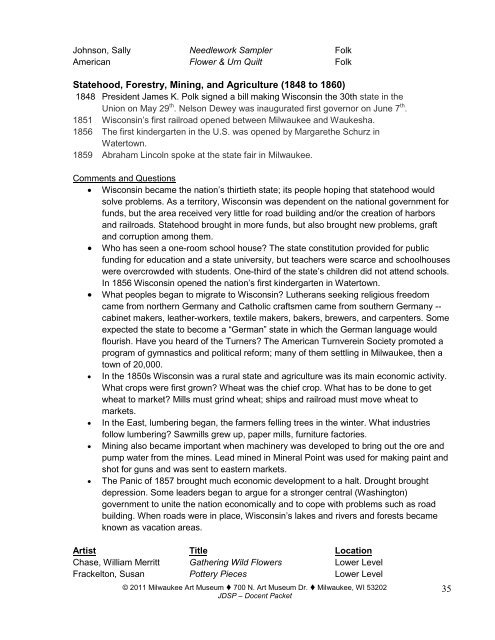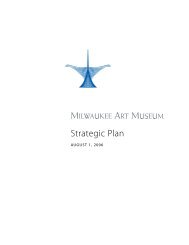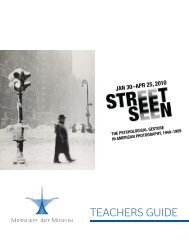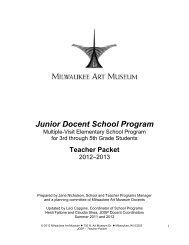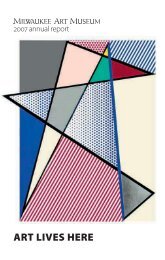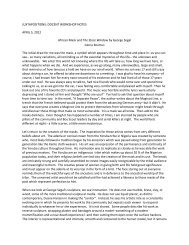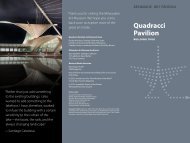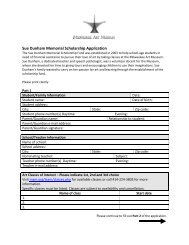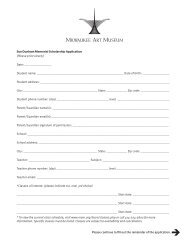Junior Docent School Program - Milwaukee Art Museum
Junior Docent School Program - Milwaukee Art Museum
Junior Docent School Program - Milwaukee Art Museum
You also want an ePaper? Increase the reach of your titles
YUMPU automatically turns print PDFs into web optimized ePapers that Google loves.
Johnson, Sally Needlework Sampler Folk<br />
American Flower & Urn Quilt Folk<br />
Statehood, Forestry, Mining, and Agriculture (1848 to 1860)<br />
1848 President James K. Polk signed a bill making Wisconsin the 30th state in the<br />
Union on May 29 th . Nelson Dewey was inaugurated first governor on June 7 th .<br />
1851 Wisconsin‟s first railroad opened between <strong>Milwaukee</strong> and Waukesha.<br />
1856 The first kindergarten in the U.S. was opened by Margarethe Schurz in<br />
Watertown.<br />
1859 Abraham Lincoln spoke at the state fair in <strong>Milwaukee</strong>.<br />
Comments and Questions<br />
Wisconsin became the nation‟s thirtieth state; its people hoping that statehood would<br />
solve problems. As a territory, Wisconsin was dependent on the national government for<br />
funds, but the area received very little for road building and/or the creation of harbors<br />
and railroads. Statehood brought in more funds, but also brought new problems, graft<br />
and corruption among them.<br />
Who has seen a one-room school house? The state constitution provided for public<br />
funding for education and a state university, but teachers were scarce and schoolhouses<br />
were overcrowded with students. One-third of the state‟s children did not attend schools.<br />
In 1856 Wisconsin opened the nation‟s first kindergarten in Watertown.<br />
What peoples began to migrate to Wisconsin? Lutherans seeking religious freedom<br />
came from northern Germany and Catholic craftsmen came from southern Germany --<br />
cabinet makers, leather-workers, textile makers, bakers, brewers, and carpenters. Some<br />
expected the state to become a “German” state in which the German language would<br />
flourish. Have you heard of the Turners? The American Turnverein Society promoted a<br />
program of gymnastics and political reform; many of them settling in <strong>Milwaukee</strong>, then a<br />
town of 20,000.<br />
In the 1850s Wisconsin was a rural state and agriculture was its main economic activity.<br />
What crops were first grown? Wheat was the chief crop. What has to be done to get<br />
wheat to market? Mills must grind wheat; ships and railroad must move wheat to<br />
markets.<br />
In the East, lumbering began, the farmers felling trees in the winter. What industries<br />
follow lumbering? Sawmills grew up, paper mills, furniture factories.<br />
Mining also became important when machinery was developed to bring out the ore and<br />
pump water from the mines. Lead mined in Mineral Point was used for making paint and<br />
shot for guns and was sent to eastern markets.<br />
The Panic of 1857 brought much economic development to a halt. Drought brought<br />
depression. Some leaders began to argue for a stronger central (Washington)<br />
government to unite the nation economically and to cope with problems such as road<br />
building. When roads were in place, Wisconsin‟s lakes and rivers and forests became<br />
known as vacation areas.<br />
<strong>Art</strong>ist Title Location<br />
Chase, William Merritt Gathering Wild Flowers Lower Level<br />
Frackelton, Susan Pottery Pieces Lower Level<br />
© 2011 <strong>Milwaukee</strong> <strong>Art</strong> <strong>Museum</strong> 700 N. <strong>Art</strong> <strong>Museum</strong> Dr. <strong>Milwaukee</strong>, WI 53202<br />
JDSP – <strong>Docent</strong> Packet<br />
35


